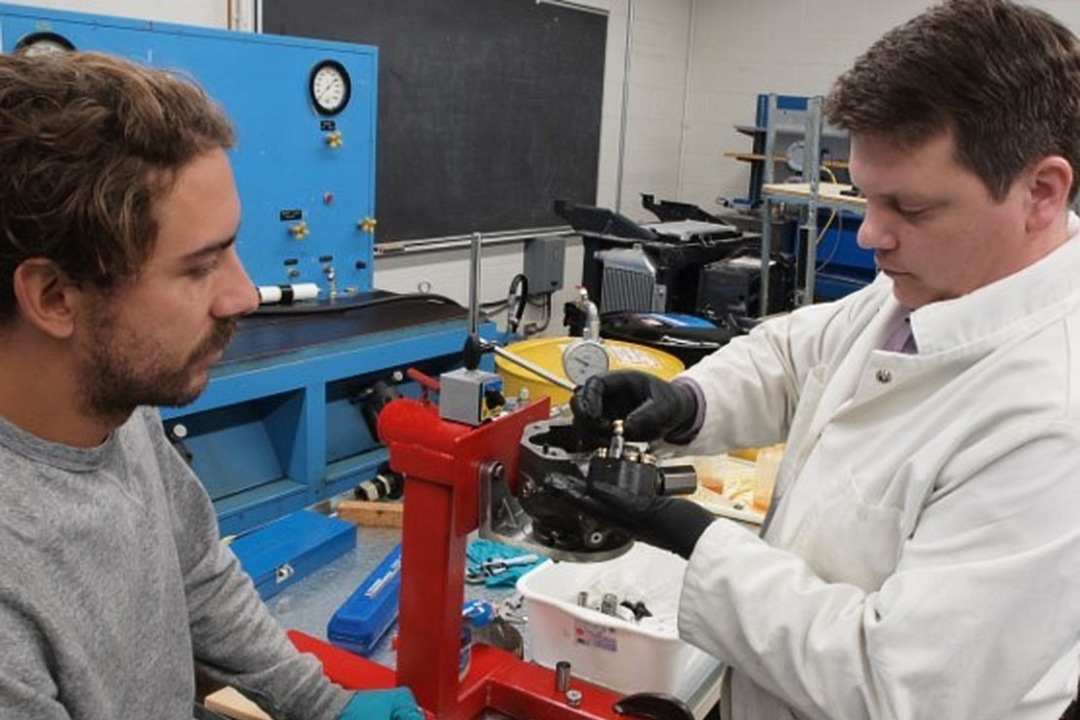
Engineering researchers and manufacturer develop technology to detect pump wear
A University of Saskatchewan (USask) research team and fluid power systems company, Wil-Tech Industries Ltd. (WTI), are partnering to develop monitoring technology for predicting the failure of hydraulic pumps - an innovation that will avoid costly shutdowns at mines and other industrial sites and help ensure worker safety.
By USask Research Profile and Impact“We are developing a new method of evaluating the service life left in a pump by using low-cost sensors that measure the outlet line pressure,” said project leader Travis Wiens, an assistant professor at USask’s College of Engineering.
“For industries such as mining, construction, agriculture, and oil and gas that use a lot of hydraulic systems, knowing when a pump needs to be replaced before it fails provides equipment reliability and efficiency—an economic advantage in a competitive global market,” said Wiens, who is working on the project with master’s student Jon Fernandes.
The project is funded with $37,500 from the Natural Sciences and Engineering Research Council of Canada, along with industry contributions. WTI, a family-owned company with headquarters in Estevan and offices in Saskatoon and Regina, is contributing $25,000 in cash as well as in-kind support jointly with Parker Hannifin, a global maker of hydraulic products. The project is funded until the end of 2019, and Wiens expects results by then.
“This technology will eventually become a product that Wil-Tech can market, either by integrating it with the pumps they are selling, or as a stand-alone service,” Wiens said. “It’s a high-tech product that will employ highly qualified personnel, and will have applications worldwide in mining, agriculture and other industries.”
Noting that a pump costs $1,000 or more, Wiens estimates that the cost of providing an external monitor will be considerably less than 10 per cent of the pump price.
“Low cost is key. Conceivably, these pressure sensors can be installed on a pump without significantly increasing the cost of the system,” Wiens said.
The pump monitor project with Wil-Tech piggybacks on various research projects Wiens is conducting at USask’s Fluid Power Laboratory in collaboration with a large mining company to evaluate anti-wear properties of fire-resistant hydraulic fluids used in pumps.
From that experiment, Wiens and Fernandes are repurposing 36 pumps, whose wear history and other data are readily available, to develop the pump life estimation technology for Wil-Tech. They will use machine learning techniques to correlate a pump’s dynamic response—its reactions to commands for pressure changes in equipment—with the condition of the pump.
“We don’t have to know if a worn machine is responding faster or slower. We give it a bunch of data, and the machine picks out which are the most important features and tells us something about the health of the pump,” he said.
Jim Wilson, president and founder of the company, said WTI services the fluid power systems operated by some of the largest companies and industries in Saskatchewan.
“We hope to bring efficiencies to our customers from this research in the immediate future. There is no doubt of the financial benefits to Saskatchewan and Canadian economies from improved equipment reliability and safety,” Wilson said.
“As a part of celebrating 25 years of business in Saskatchewan, we set out to give back to the province and industry that have been key to our success. That’s when we began a conversation with Travis Wiens at the College of Engineering’s Fluid Power Lab. We are proud to have facilities like this in our province.”

